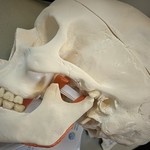Disorders of the Jaw
TMJ disorders refer to problems affecting the temporomandibular joint (TMJ), which connects the jawbone to the skull. These disorders can cause pain or discomfort in the jaw, face, or neck, and may lead to difficulty chewing, jaw clicking or popping, or even the jaw locking open or closed. TMJ disorders can result from injury, arthritis, teeth grinding (bruxism), or stress-related muscle tension.
TMJ Disorders
The TMJ is the joint that connects your mandible (jaw bone) to the temporal bones of your skull and is essential for various activities like speaking, chewing, and yawning. TMJ disorders can cause pain and dysfunction in the jaw joint and the muscles that control jaw movement.
Symptoms may include headaches or facial pain, neck pain, jaw pain, or clicking. As well as ringing in the ears, ear fullness, ear pain, noise sensitivity, or teeth pain. Many patients are unaware that jaw dysfunction can contribute to these symptoms and can be treated!
Diagnosing TMJ disorders involves a thorough examination of the jaw, neck and the surrounding soft tissues.
Treatment for TMJ disorders can vary based on the severity of symptoms and the underlying causes. Conservative measures include learning self-care principles for the jaw such as learning how to relax the muscles and may include temporary lifestyle modifications such as a soft diet, avoiding larger mouth openings and avoiding chewing gum. Directed manual therapy (joint and soft tissue mobilizations), IMS/dry needling and exercise prescription can be incorporated into the treatment plan. Stress is often associated with TMJ disorders. It can contribute to clenching and grinding of teeth and sensitize information to and from the brain that can contribute to increasing muscle tension. Stress management techniques, diaphragmatic breathing and relaxation exercises, may be beneficial in managing symptoms. In some cases, dental devices such as mouthguards may be recommended to manage symptoms in conjunction with your dentist. Your Physiotherapist will communicate directly with your dentist to involve them in your treatment plan.
Sophia Sauter, Registered Physiotherapist, has a special interest and post-graduate training in the treatment of TMJ disorders. These patients are seen at either our of our two locations.




